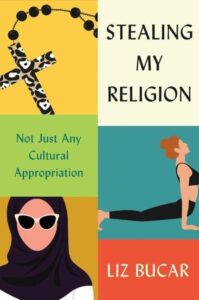When Liz Bucar was 11 years old, she saw the pop singer Madonna wearing a cross necklace. She got her own and started wearing it, even though she was — for all intents and purposes — “borrowing” the style from a religion she didn’t practice.
In the years since her childhood emulation of the Material Girl, Bucar has become an expert in religious ethics. Now, she’s studying where the line falls between simply borrowing from a religious culture and cultural appropriation.

Whereas cultural appropriation is the use of a minority or significantly ‘other’ culture’s traditions or cultural elements in ways that are exploitative, lack understanding or show disrespect, Bucar says the gray area of borrowing is different. She said she wanted to introduce a morally neutral term into the conversation, telling RNS that religious borrowing has always existed.
It’s certainly a big part of the way religion in America is experienced and consumed, especially if you think about the spiritual but not religious or the nones. Some forms of cross-tradition borrowing are positive. For me, borrowing is the bigger category and appropriation is the problematic form. And the reason it’s problematic, for me, is when the borrowing happens in conditions of injustice, oppression and power inequities. That’s what generates harm. So a good intention doesn’t get you off the hook. You have to zoom out and look at bigger structures. It becomes a way to think about your position to religious communities you’re not part of, and your position of privilege in the world in general, and how complicated that is.
Bucar said that whereas progressive secularists can be positioned in a way that makes them more likely to fail to properly differentiate religious positions, sometimes people who fall into the spiritual-but-not-religious camp can be tempted to borrow without considering the full consequences of their actions.
By definition, they say religion is not for them and are insistent that spirituality is something really different from religion. But as a scholar of religion, I believe spirituality is what they are calling the pieces of religion that they like. They are often self-curating their spiritual and devotional practice, but I’m not sure they are always taking seriously that that process can sometimes make oppression worse. I don’t know if that’s part of their calculation when they decide if they want to burn some sage or wear a rosary.
In her work, Bucar did several case studies of what she considered gray areas. One of the case studies was of the so-called ‘Solidarity Hijab’, in which western feminists and other liberals put on an Islamic headscarf in an effort to stand against gendered Islamophobia. Part of the problem, Bucar said, is that the effort actually centered secular white feminism and made some Muslim women feel tokenized, and part was that it ignored the fact that 50 percent of U.S. Muslim women don’t wear hijabs.
In the case of teaching secular yoga to make it more accessible, Bucar said, deculturalizing the practice so that she didn’t feel like she was pretending to represent South Asian traditions led to a realization that “appropriation is not only what you borrow, but what you leave behind.”
And I realized I had bought into the idea that there was something dangerous about Eastern religious practices, or the religious content of yoga and that there was something safer about a white woman teaching yoga practices. And so I then no longer felt comfortable teaching yoga in that space. I felt like what I was erasing was contributing to structural injustice. But I didn’t realize that until I tried it out.
Bucar also used a case study of the study-abroad program she had developed for students in Spain that included walking the last 150 miles of the Camino de Santiago — an ancient network of pilgrimage routes ending at the tomb of St. James — even though most of them were non-religious or Protestant. “When I think about how I’d go about it again,” she told RNS, “I would ask students to center the discomfort around searching for authenticity and self-actualization by borrowing someone else’s practice and extracting the essence of it.”
Moving forward, Bucar said responsible ‘borrowing’ will have to include personally taking on the idea that one is entitled to such borrowing. She continues:
The other thing is to admit that we are engaged in religion and not keep insisting that our spiritual practices are not religious or that we are somehow better than religious practitioners. Engaging with the question of religious appropriation is an opportunity to learn about your position and relation to systems and structures of injustice, rather than believing you are entitled to take whatever you want for your personal enrichment.







